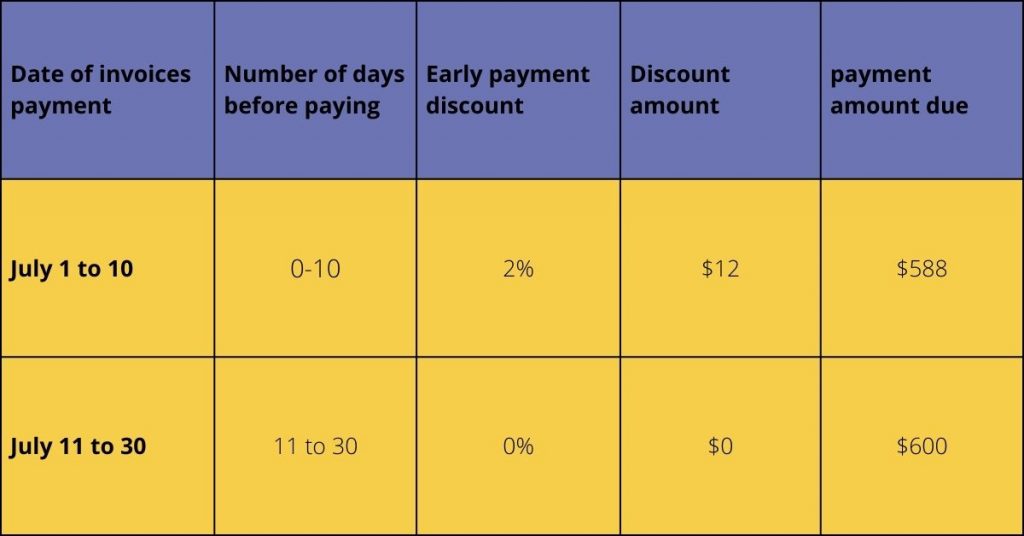06 Jul

2/10 net 30 is one of the most popular payment terms on the market today. It’s also a reliable way to buy a good number of items without having to worry about monthly bills, paying a lot, or even any interest.
It’s a way to test the market for your business on the cheap. Not only do you not get any money upfront, but it’s also budget-friendly
The 2/10 net 30, sometimes known as “210 net 30” or just “2/10”, is a financial calculation used to determine the discount amount in case of early payment to a credit. The term “net 30” is a reference to the fact that the payment is due both in full and thirty days after issuing the invoice; this corresponds to 31 calendar days. This article gives you insight into the 2/10 net, its calculation, and its pros and cons.
2/10 net 30, meaning
2/10 net 30 refers to the trade credit the seller offers customers for the sale of goods and services. In this case, if the amount due is paid within 10 days, the customers get a 2% discount. Otherwise, the amount is due in full 10 after 10 days. So the “2” represent the discount amount of 2%, and the “10” represents the due date.
How do you calculate 2/10 net 30
Let’s understand through an example:
Suppose a trading company sells $600 worth of goods to the customers on July 1. If customers pay the net amount between 1 to July 10, they will receive a discount of 2% of 2%.
Invoice details
- Invoice full amount: $600
- Invoice date: July 1
- Invoice due date: 30 days
- Payment term: 2/10 net 30
- Discount period: 110 days
The formula for discount invoice
100%-Discount % invoice amount
100-2%%$600
98%$600=$588
It means the trading company would like to have $10%for a total payment of $588 if the company paid between 1st to July 10.

Pros and cons of 2/10 net 30
There are always pros and cons to any practice during business transactions. The following are the pros and cons of 2/10 net 30.
Pros of 2/10 net 30
The 2/10 net 30 payment terms have some benefits, including longer terms and quicker payment, so it may be worth trying for businesses that need extra time to collect payments. Also, this payment term could be beneficial if you have plenty of cash flow with no inventory – these characteristics allow you to use your funds when they are collected rather than sitting on them until your bills are due.
Cons of 2/10 net 30
A business that operates on a 2/10 net 30 payment cycle will never be successful. The main reason is that the waiting period will not allow them to have customers. No one will want to place an order if they have to wait over two weeks before receiving their money, which will result in lost profit, lack of future sales, and the company being closed down.
Some other trade terms like 2/10 net 30
Here are some trade terms similar to 2/10 net 30 are as under:
2/10 net 45
2/10 net 45 means a 2% discount will be given if a customer pays within 10 days to the sellers. Otherwise, the total amount is due 10 after 10 to 45 days of the invoice date.
3/10 net 30
3/10 net 60 means a 3% discount will be given if the customer pays within 10 days to the sellers. Otherwise, the total amount is due 10 to 30 days after the invoice date.
3/20 net 60
3/20 net 60 means a 3% discount will be given if the customer pays within 20 days to the seller. Otherwise, the total amount is due after 20 to 60 days of the invoice date.
Net 20 EOM
Net 20 EOM means the total amount is due for full payment within 20 days after the end of the month.
2/EOM net 45
2/EOM net 45 means customers receive a 2% early discount if the customer pay at the end of the month (EOM). Otherwise, the net amount is due within 45 days of the invoice date.
Conclusion
Summing up the above article, 2/10 net 30 is a contract that allows you to receive a payment within 30 days upon the customer’s receipt of the invoice. The 2/10 means that the customer has two weeks, 14 days from the day they receive your invoice. The 10 stands for ten days or the last day of the grace period.
Shabana has been a committed content writer and strategist for over a 5 years. With a focus on SaaS products, she excels in crafting compelling and informative content.
Related Post
Copyright © 2024 – Powered by uConnect



Shabana